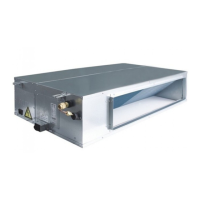GREE U-Match 6 SERIES UNIT SERVICE MANUAL
90
Check the condition of the damaged compressor, including its position and model.
If the information of the compressor is confirmed, check the oil quality.
(a) If the oil is clear and impurities-free, we consider that the oil of the system is not polluted.
Meanwhile, if we confirm that the valves and pipes are also normal, then we can replace the compressor
only. For the removal of compressor, please refer to the section: Removal of Major Components.
How to check oil quality:
(1) After the compressor is detached, put it on a solid ground and shake it at an angle of 30~45° to
ensure that the contaminant at the bottom of the compressor can be poured out.
(2) Place the compressor at a position above the ground level and then pour out the oil from the air
outlet of the compressor. Collect the oil in a transparent container. The amount of oil should be
over 150ml.
Note:
1) The axial direction of the compressor should not slant at an angle larger than 20° to the
horizontal direction.
2) Prevent the compressor from falling.
3) Put a transparent container (over 150ml in volume) under the exhaust pipe to collect the
compressor oil, thus we can see the oil quality.
(3) Put the container of compressor lubricant in a bright location and see if there is impurity and
discoloration. Sniff at the compressor lubricant. Normally, there is no pungent smell.
(b) If the oil is contaminated, replace the compressor and the gas-liquid separator.
Note:
Confirm whether the compressor needs to be replaced. The pipe mouths of the faulted compressor
must be sealed by adhesive tape as soon as the compressor is detached. Make sure the compressor is
well preserved for the ease of future analysis.
Step 6: Check the components
If the oil is contaminated, check the components of the unit, including the gas-liquid separator.
Check the gas-liquid separator

